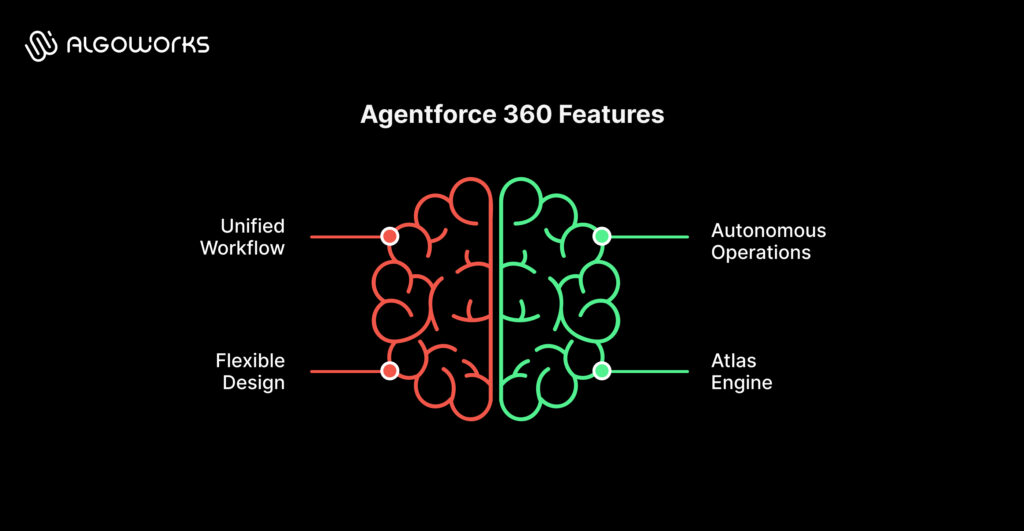Dreamforce 2025 highlights: why every enterprise should pay attention to Agentforce 360

Dreamforce 2025, which took place just a few weeks ago, marked a clear inflection point for Salesforce and its ecosystem. Agentforce 360, Data 360 and Revenue Cloud are converging to define the Agentic Enterprise. Where AI agents don’t assist from the sidelines, they act in core workflows.
The takeaway was unmistakable: AI agents aren’t coming; they’re already in production. Salesforce now counts about 10,000 paid Agentforce customers, up from 6,000 earlier this year. Enterprises still drafting AI strategies may already be behind the curve.

What actually changed
Agentforce 360 isn’t another AI add-on. It’s now generally available and acts as the backbone of the Agentic Enterprise, enabling autonomous agents to handle lead qualification, support, billing, IT tickets, disputes and forecasting with context and continuity. These trends aren’t just predictions; they’re shaping how enterprises structure their CRM ecosystems today. You can learn more about that evolution in our Salesforce development services.
Salesforce report around 12,000 Agentforce customers overall, though many remain in pilot mode. Around 25% of customers are testing Agentforce; fewer than 10% have scaled beyond proofs of concept. The gap isn’t technical; it’s organizational readiness.
Agentforce 360: unified, autonomous and flexible
Here’s why this announcement isn’t just another AI headline:
Unified workflow: One platform across Customer 360 Apps (Sales, Service, Marketing Cloud and Slack. Your agents don’t live in silos. They share context, collaborate and hand off work seamlessly. When a service agent resolves a customer issue, the sales agent automatically knows about it and adjusts its outreach strategy.
Autonomous operations: These aren’t chatbots waiting for prompts. They’re proactive workers. A lead comes in at 2 AM? The agent qualifies it, checks your inventory, generates a quote and books a meeting; all before your team logs on in the morning.
Flexible design: You’re not locked into Salesforce’s AI models. Want to use OpenAI? Claude? Google’s models? Go ahead. Agentforce 360 lets you bring your own LLM while maintaining all the governance and security controls your compliance team demands.
Builder updates: New AgentScript, conversational builder, real-time simulator and early voice capabilities streamline design and testing.
All of it runs on Atlas, Salesforce’s reasoning engine that blends deterministic workflows with LLM-driven logic. Early deployments center on support, internal IT and sales development, while industries like finance and manufacturing are testing end-to-end automations. And don’t miss how improving employee adoption directly relates to ROI in Salesforce; read our piece Driving Salesforce ROI through better employee experience.
Data 360: the intelligence layer
AI fails without clean, connected data. Data 360 (formerly Data Cloud) is Salesforce’s fix; real-time streaming, zero-copy architecture, semantic search via embeddings and governance-first controls.
It’s the prerequisite for every successful agent rollout. Many large deals right now are data modernization projects, not AI pilots. Without unified data, intelligence collapses under inconsistency
The highlights:
- Real-time streaming with sub-second data freshness
- Zero-copy architecture for federated access without duplication
- Semantic understanding via vector embeddings for unstructured data
- Governance-first controls with masking, roles and compliance
What this unlocks is reliability. Decisions are no longer reactive; they’re predictive. Clean, unified data means agents can drive renewals, forecast accurately and surface insights that humans can act on.
This aligns with what many digital leaders have learned the hard way; AI doesn’t fail because of bad algorithms; it fails because of bad data.
Trust & governance: how do you control autonomous AI?
Enterprise adoption hinges on safety. Salesforce’s Einstein Trust Layer offers full audit trails, PII masking, toxicity detection, and confidence-based human escalation. It’s the strongest enterprise-grade guardrail model in market today, essential for aligning IT, legal, compliance, and security before deployment. Once those loops close, scaling accelerates rapidly.
No-code agent building
Here’s where Salesforce made a brilliant move. They’re democratizing agent development. Your Salesforce admins, the people who already understand your business processes, can now build agents with Agentscript, conversational builders and the simulator, no code required.
Setup powered by Agentforce lets admins describe what they need in plain English: “Create a flow that routes high-value leads to enterprise reps and notifies them in Slack.” The agent builds it, deploys it and tests it. What used to take days now takes minutes. Agentforce Vibes auto-generates dashboards, apps and flows in seconds. Conversational Agent Builder turns plain-language logic into agent behavior.
This levels the field. Teams no longer wait on AI specialists; they become them. Speed becomes the differentiator and enterprises that enable citizen builders move twice as fast.
Revenue Cloud
Revenue Cloud evolved from a process optimizer to a predictive command center. Agents now recommend pricing, detect billing anomalies and predict renewal risks long before revenue leakage occurs. This results in:
- Faster quote-to-cash cycles
- Fewer errors
- Smarter renewals
- Accurate forecasts
This isn’t about automating existing processes. It’s about making your revenue operations autonomous and intelligent.
Slack: the agentic hub
Slack is becoming the agentic OS for collaboration. Agents now surface leads, tickets, and approvals directly in channels. Auto Slack setup and enhanced bots bring CRM context into workspace conversations. It also integrates with Teams and external LLMs (OpenAI, Claude, Gemini). Even Agentforce IT Service, built to rival ServiceNow, shows how deeply agents are being embedded into daily workflows.
Pricing that encourages scale
Salesforce also tackled enterprise pricing head-on with the Agentic Enterprise Licensing Agreement (AELA); a model that bundles Agentforce and Data 360 usage into one predictable package.
No per-user constraints, no hidden usage spikes. Enterprises can scale agents freely; mid-market companies can use flex or action-based pricing. It’s a pragmatic move aimed at accelerating real adoption.
Why Agentforce 360 stands apart
Competitors are bolting AI onto legacy architectures. Salesforce rebuilt its platform around it.
- Unified, governed, contextual. Agents operate natively within your CRM.
- Production-ready. Designed for real workloads, not experiments.
- Ecosystem-driven. Partners and admins can extend it without custom engineering.
Yes, ServiceNow and hyperscalers are strong contenders but enterprise systems still need the domain context, permissions, and customer logic that Salesforce already owns. This is the difference between AI tools and an AI-driven operating model.
What enterprises should do next
The organizations that succeed next year will be those deploying at scale, not still drafting AI plans.
- Start with data. Run a Data 360 readiness check.
- Target one outcome. Choose a high-impact use case.
- Use the builder. Leverage AgentScript and simulator to validate logic.
- Close the governance loop. Apply Trust Layer controls.
- Plan licensing early. Model AELA workloads.
This isn’t about replacing teams; it’s about amplifying them. At Algoworks, we design systems that make humans more capable, not less relevant. Understanding the top Salesforce trends in 2025 can help enterprises stay ahead as this transformation unfolds.
The bottom line
Dreamforce 2025 drew a clear line between organizations that adapt and those that wait. Salesforce aims for $60 billion revenue by 2030, driven by AI-powered growth. Partners are already seeing 5–10% revenue gains, with room to double as adoption matures.
The message: this shift is irreversible. Data readiness, governance, and cross-team alignment take time but enterprises that start now will capture the compounding advantage. Before diving into Agentforce, consider running a comprehensive Salesforce AI health check to ensure your foundation is ready for autonomous agents.
Ready to explore how Agentforce 360 fits your enterprise? Contact Algoworks today.
FAQs
What is Agentforce 360, and why is it a big deal?
Agentforce 360 is Salesforce’s AI platform where autonomous agents work directly inside your CRM to handle real business tasks; qualifying leads, resolving cases, forecasting revenue, and more.
How is Agentforce 360 different from Einstein or Copilot?
Einstein analyzed data; Copilot assists users. Agentforce 360 goes further; it acts. Powered by Salesforce’s new Atlas reasoning engine, it lets agents plan, execute, and learn from every workflow across Sales, Service, and Slack. It’s about operational automation, not just insights.
Why does Data 360 matter before deploying Agentforce?
AI agents are only as smart as the data they use. Data 360 ensures your information is real-time, unified, and governed; so agents can act confidently without relying on fragmented or duplicate data. Think of it as the intelligence layer that makes every agent decision trustworthy.
Can enterprises use their own AI models within Agentforce 360?
Yes. Salesforce made Agentforce 360 model-flexible. You can bring in OpenAI, Claude, Gemini, or any preferred LLM while still using Salesforce’s enterprise-grade governance, compliance, and audit controls. That flexibility is one of its biggest advantages.
How can enterprises get started with Agentforce 360?
Start by fixing the foundation; implement Data 360 for clean data, identify one high-impact use case, and empower Salesforce admins to experiment using no-code tools. The key is to move from pilot to production fast, measure outcomes, and iterate as your teams and governance mature.

